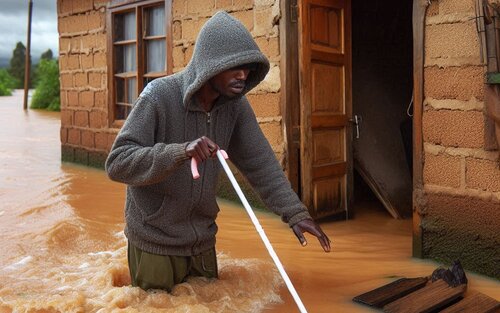Climate disaster Management and Emergency Planning for Persons with Disabilities
It is essential to prioritize Climate Disaster Management and Emergency Planning for persons with disabilities. This article explores key considerations and actionable steps to make disaster response more inclusive

A visually impaired man finding his way through a flooding situation (Copilot)
How to Get Assistance During Climate-Related Disasters as a Person with Disability
Climate-related disasters such as floods, droughts, heatwaves, and storms are becoming more frequent due to climate change. These emergencies often create additional barriers for persons with disabilities, making it critical to have disaster preparedness plans that ensure safety and timely access to assistance. Whether you're facing floods, wildfires, or severe storms, knowing your rights, available services, and steps you can take can help you navigate such situations more effectively.
1. Create a Personal Emergency Plan
Having a personal emergency plan tailored to your needs is essential. This plan should include:
- Contact Information: Identify emergency contacts, including family, neighbours, and local authorities, who can offer assistance.
- Communication Needs: If you use assistive technology or alternative communication methods, make sure emergency contacts are aware of how to communicate with you. Share any special instructions on how to assist you in case of evacuation.
- Essential Supplies: Prepare an emergency kit with essential supplies such as medications, mobility aids, assistive devices (e.g., hearing aids or communication devices), and a power bank for electronics. Ensure that these items are easily accessible.
- Evacuation Routes: Map out accessible evacuation routes that accommodate your mobility needs and are close to emergency shelters or safe locations.
2. Know Your Rights
Persons with disabilities have a right to be included in all emergency planning and disaster relief efforts. Understanding your rights under national laws and international agreements like the UN Convention on the Rights of Persons with Disabilities (CRPD) can help ensure you receive equitable access to assistance. For instance, Article 11 of the CRPD mandates that governments take necessary measures to ensure the protection and safety of persons with disabilities during emergencies.
3. Connect with Local Disability Organizations
Before a disaster occurs, connect with local disability organizations or advocacy groups, which can provide valuable information and resources tailored to the needs of persons with disabilities. Many organizations offer support with:
- Emergency Planning: Helping you build personalized emergency plans.
- Legal Assistance: Advocating for your rights to ensure accessible shelters, transportation, and medical care.
- Information on Available Services: Providing guidance on government and NGO-led disaster response services, including how to access them during a crisis.
4. Access Government Assistance Programs
The government’s disaster response agencies, such as the Kenya Red Cross, are involved in relief efforts. These agencies often coordinate evacuation, temporary shelter, and food distribution. However, it is important to ensure that these services meet the accessibility needs of persons with disabilities. For example, emergency shelters should be equipped with ramps, accessible toilets, and spaces for assistive devices.
- Reach Out Early: Contact disaster management agencies early to inform them of your location and needs. Many countries also offer early warning systems through SMS and mobile apps that are accessible to persons with disabilities.
- Accessible Shelters and Medical Aid: Ensure the shelters you are directed to are accessible. If not, report the issue to authorities or disability advocates who can intervene.
5. Community-Based Disaster Support
Forming strong connections within your community is essential. Neighbors, friends, and community members can assist you in disaster situations, especially when government resources may be stretched thin. Engage with community disaster management programs and educate your local community about the needs of persons with disabilities during emergencies.
- Volunteer Groups: Many communities have volunteer networks that assist vulnerable groups, including persons with disabilities, during emergencies. Ensure you are registered with these groups and keep them informed of your needs.
6. Utilize Technology and Assistive Devices
Technology can be a life-saver during climate-related disasters. From early warning systems to assistive technology that helps with evacuation, persons with disabilities can leverage tech tools to stay safe.
- Mobile Alerts and Apps: Register for mobile alerts through national disaster management agencies. These systems often send out warnings about incoming disasters, giving you time to prepare.
- Assistive Devices: Ensure your assistive devices (hearing aids, wheelchairs, communication devices) are always charged and functioning. You may also want to invest in solar-powered chargers or portable power banks to keep these devices powered in case of prolonged power outages.
7. Advocate for Inclusive Policies
Many disaster relief efforts fail to consider the specific needs of persons with disabilities, making advocacy crucial. Engage with local authorities and policymakers to ensure that emergency preparedness plans are inclusive of persons with disabilities. Some actions you can take include:
- Push for Accessibility: Advocate for accessible evacuation routes, shelters, and communication systems.
- Demand Representation: Ensure that persons with disabilities are included in disaster planning committees at the community, county, and national levels.
8. Post-Disaster Recovery Assistance
After the immediate danger has passed, persons with disabilities may still face barriers during the recovery process. Seek assistance for:
- Accessible Housing: If your home has been damaged, ensure that any temporary or permanent housing you are provided with is accessible.
- Mental Health Support: Climate-related disasters can take a toll on mental health. Seek out accessible mental health resources through disability organizations or government agencies.
- Financial Assistance: If you have lost your livelihood or property, inquire about available government programs that offer financial relief to persons with disabilities.
Climate-related disasters can disproportionately affect persons with disabilities, but with adequate preparation, awareness, and advocacy, you can ensure your safety and access to assistance. By creating a personal emergency plan, knowing your rights, leveraging local networks, and utilizing technology, you can mitigate the risks posed by these disasters. It is also crucial to push for inclusive disaster management policies to ensure that no one is left behind.
Article by: Maryanne Emomeri
